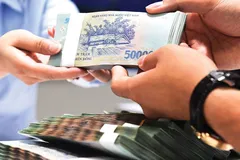
Remarkable Profit Growth
Despite economic challenges, many banks in Vietnam recorded substantial profit growth in the first nine months of 2024. Leading the pack is LPBank, which reported a pre-tax profit of VND 8,818 billion, marking an astonishing 139% increase compared to the same period last year. This figure represents 84% of the bank’s annual profit target, showcasing its strong performance.
Similarly, HDBank achieved a profit of VND 12,655 billion, a 47% increase year-on-year, meeting 79.8% of its yearly goal. Eximbank also posted an impressive pre-tax profit of approximately VND 2,378 billion, up 39% from the same period in 2023. Notably, its third-quarter profit alone reached nearly VND 904 billion, three times higher than the previous year’s third quarter.
Other major players also saw notable gains. Vietcombank maintained its top position in profitability, with a pre-tax profit of VND 31,533 billion, up 7% year-on-year. Following closely were Techcombank and BIDV, with pre-tax profits of VND 22,842 billion (up 33.5%) and VND 22,047 billion (up 12%), respectively. MB, VietinBank, ACB, and SeABank also demonstrated positive growth, achieving substantial profit increases ranging from 2% to 43%.
Even smaller banks like Kienlongbank managed to achieve significant growth, with a 19% increase in profit, totaling over VND 760 billion.
However, not all banks shared in the success. Some reported declines in profit, highlighting disparities within the sector. VIB's profit fell 21% to VND 6,600 billion, while MSB saw a 6.15% drop, reaching VND 4,901 billion. Similarly, PGBank's profit declined by 4.4% to VND 344 billion.
Mounting Concerns over Bad Debt
Despite the impressive profit numbers, a troubling trend has emerged: a significant rise in bad debt across the banking sector. By the end of the third quarter, the total bad debt of 29 banks had increased by VND 56,485 billion, up 27.9% from the end of 2023. This concerning figure underscores the growing challenge of maintaining credit quality.
Several banks experienced a surge in their bad debt ratios. BIDV and VietinBank, two of Vietnam’s largest banks, saw the most substantial increases. BIDV’s bad debt rose by 49.3% to VND 33,386 billion, pushing its bad debt ratio to 1.71%. VietinBank faced a similar scenario, with bad debt increasing by 39.8% to VND 23,225 billion.
MSB reported a bad debt ratio of 2.88% by the end of the third quarter, driven by a sharp 66% increase in group 5 debt (debts unlikely to be recovered), totaling over VND 3,008 billion. TPBank also faced difficulties, with its bad debt ratio climbing from 2.05% at the start of the year to 2.29%.
Eximbank's total bad debt surged by 15.86% to over VND 4,300 billion, pushing its bad debt ratio from 2.65% to 2.71%. Group 3 and group 5 debts saw significant increases of 43% and 51.2%, respectively.
Even banks that reported profit growth, such as VietABank, experienced worsening credit quality. VietABank’s bad debt increased nearly 20%, reaching VND 1,316 billion, with its bad debt ratio rising to 1.7%. Particularly alarming was the 72% increase in group 5 debt, which reached VND 868 billion, while group 4 debt skyrocketed sixfold to VND 132 billion.
MB’s bad debt balance also grew by 60%, totaling VND 15,685 billion, and raising its bad debt ratio from 1.6% to 2.23%. Group 3, 4, and 5 debts all recorded significant increases, indicating broader challenges within the bank’s credit portfolio.
Rising Provisions Impact Profitability
In response to the surge in bad debt, banks have had to increase their provisioning for credit risks, which in turn has impacted their profitability. For example, VIB, with a bad debt ratio of 2.67%, allocated approximately VND 3,230 billion in provisions over the past nine months.
ABBank also reported lower-than-expected profits due to increased provisions, citing challenging market conditions exacerbated by natural disasters.
Recent data from the State Bank of Vietnam (SBV) further highlight the issue. By the end of September, the system-wide on-balance sheet bad debt ratio had risen by 4.55% compared to the end of 2023. According to a report from SSI Research, bad debt ratios in state-owned and privately-owned banks reached 1.49% and 2.59%, respectively, in the third quarter.
However, some experts argue that these figures may not fully reflect the true extent of bad debt. The SBV’s extension of Circular No. 02/2023/TT-NHNN, which allows for restructuring of debt repayment terms and maintaining debt classifications, has provided temporary relief for struggling borrowers but may obscure the actual level of bad debt.
Despite efforts to manage bad debt, banks continue to face significant hurdles in debt recovery. The SBV has introduced a legal framework enabling the Vietnam Asset Management Company (VAMC) and debt trading firms to assist in resolving bad debts. Yet, the process remains slow and challenging.
Banks are employing various measures, including urging customers to repay loans, auctioning assets, and working with VAMC. However, these efforts have yielded limited success, and many debts remain unresolved.
The rising tide of bad debt poses long-term risks to the banking sector. High levels of non-performing loans (NPLs) can erode capital, limit credit expansion, and ultimately impact profitability. While banks are enjoying robust profits today, the specter of bad debt looms large, threatening future stability.
As the economic landscape continues to evolve, banks must balance their pursuit of growth with prudent risk management. Effective bad debt resolution will be crucial to ensuring the sector's resilience and maintaining investor confidence in the years ahead.




















